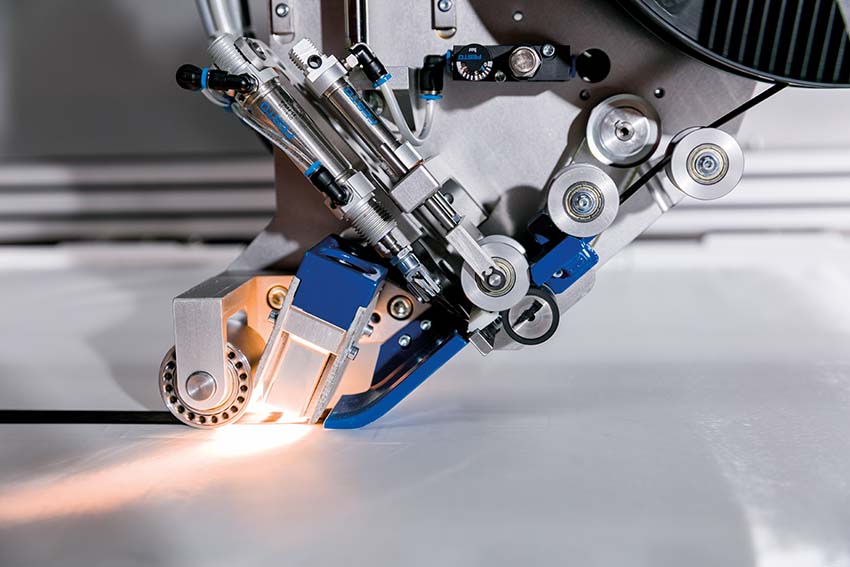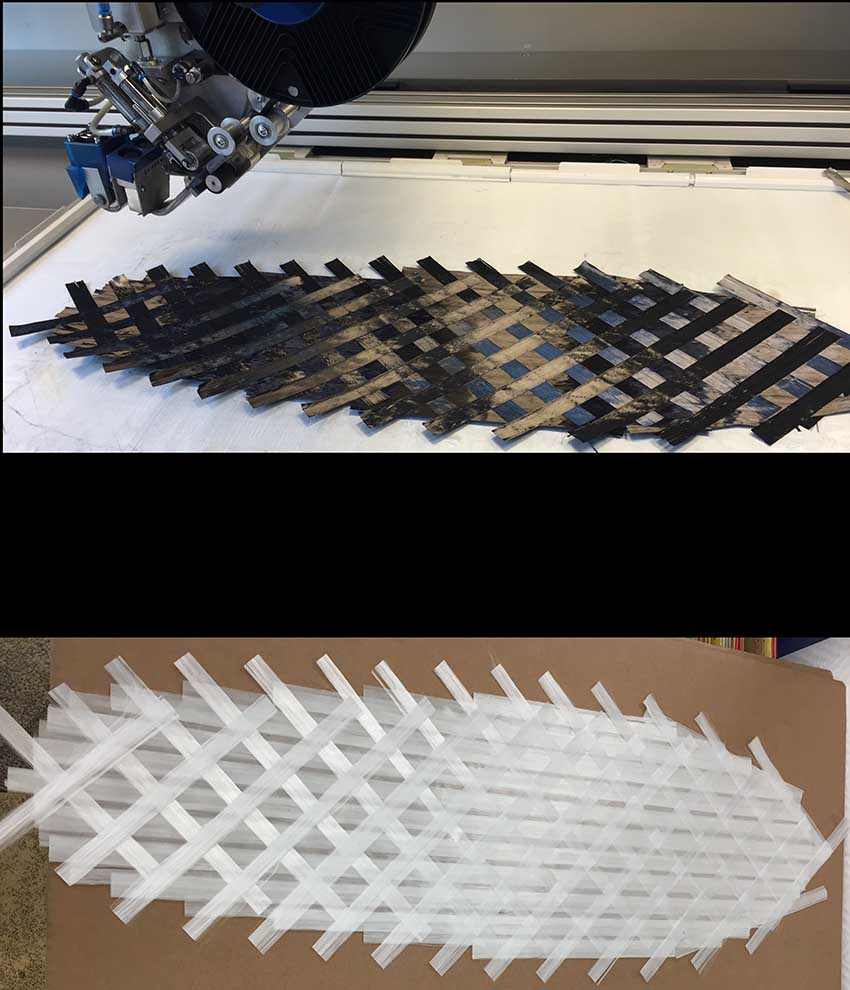M & A DIETERLE (since1964) is an established provider for the development and construction of tailor-made machinery and components for the textile and paper industry. For the past 7 years. The company has built a new business units related to fiber reinforced plastics (FRC): From heavy metal to lightweight fiber processing machinery.
Their (FRC) Unit offers modular, cost-efficient and flexible machines for automated fiber processing – from fiber spreading and impregnation to fiber placement.
Easy Engineering: What are the main areas of activity of the company?
M & A DIETERLE: Construction of tailor-made machinery and components (from metals) for textile, paper, medtech and construction industry. Generally, we can process metal components up to 40 tons of unit weight. Additonally, we engineer novel machine solutions and have extensive experience and know-how especially from the textile and paper application areas.
It was evident to start activities in composites with a focus on fiber processing.
Customer focus areas are:
- Composite manufacturing companies along the value chain from fiber processing to preforming.
- Companies who want to switch from manual to automated processes, e.g. sports equipment, etc.
- R&D companies / institutes: looking for cost-efficient fiber processing equipment for training students and personnel.
E.E: What’s the news for 2021 about new products?
M & A DIETERLE: Our latest development, the CROSSLAYER is a cost-efficient machine which enables automated preforming with either prepreg or dry fiber placement. We designed two different laying heads – one for resin-based prepreg material, the other for dry tapes.
Control the process chain: start with a fiber roving and make a preform.

E.E: What are the ranges of products?
M & A DIETERLE: All our machines are designed for ease of use and maximum flexibility.
With a focus on composites our products are:
1. UD FixedTow Machine
You can spread a fiber roving and powder-fix the tow to obtain a thin ply tape ranging from 50 gsm to 150 areal weight. You can easily switch the starting fiber or starting powder. The machine offers lots of flexibility.
2. Crosslayer Machine for
automated 2D dry fiber placement or pregpreg placement. You can lay preforms from the tape you just produced on the UDfixedTow machine or use external material. You can “tune” materials for optimal use in your process chain and application.

3. Fiber Discovery Modules:
You can also obtain customized fiber processing machines for ranging tasks such as fiber spreading, sizing, and impregnation. We can run experiments beforehand at our site to help you chose the ideal module combinations.
All machines are designed for ease of use and maximum flexibility.
Customers can chose to start with 2 machines immediately and therefore make their own dry fixed Tow Tape material lay preforms with the second machine. Or they can start with 1 machine first, and later on add more modules. We will continue to build up this platform.
Services
We can produce materials (fixedTow, sizedTow, preforms) as subcontractor, but we also value Co-Development projects.
Composites is a cross-sectional technology. You need to work together along value chains to obtain optimal solutions.
E.E: At what stage is the market where you are currently active?
M & A DIETERLE: For metal and machine parts, we are an established provider.
For composites, the market is in an early stage. Here, we target markets where production flexibility for changing products are required. This could be in sports, medtech, for example. For those applications, manual processes for composites production are replaced with automated processes. This offers better process control, less scrap and deficient products. The Covid crisis also showed the fragility of the supply chain.
Therefore the trend is also to bring production back from Asia to Europe.

E.E: What can you tell us about market trends?
M & A DIETERLE: For the ongoing transformation to more ressource efficiency, e-mobility, energy savings, FRC will play a key role. There will be an increase in lightweight materials, hybrid materials and composite use overall. For example for mobility (bikes, cargo bikes), sports, drones, medtech, machines, etc. you need reliable and robust processes to make and design new products. With the right material mix in the right place for ressource efficiency. Ideally from environmentally sustainable or recycled sources.
For that you need machines for fiber processing and composite production that are easy to use, easy to service, fast to learn and operate – and of course with flexible starting material usage.
For some markets, such as the aerospace industry, FRC are an established and valued material.
For other market segments, a broader understanding and use would increase the overall market size. From the perspective of a company like us who used to process mostly metals, learning composite production is very complex when you want to get started. The hurdles are too high. How to construct with FRCs is empirical. People make new products based on in-house experience.
Therefore we wanted to change this: we gathered know how from composite and textile experts and learned from the. We offer easy to learn and use machinery. We want to simplify processes and also help companies to switch from manual processes to affordable automation.
By mastering the process steps from fibre modification up to the component production, value chains can be adapted and optimized for their targeted application. Tomorrow’s production will be characterized by a high degree of flexibility – machines can be modified for different tasks: with one machine platform, the user can chose for example between prepreg or dry fibers placement or between liquid or powder roving impregnation.
A key element for the broader application of fiber composite technologies is to make it easier for non-specialists to enter the market. It was our goal with these machine innovations to make processes transparent, easy to learn and implementable.
We are always looking for collaboration partners. Either to develop new machine modules or to use the machines for process improvements. These special times call for more innovations.

E.E: What are the most innovative products marketed?
Our latest development, the CROSSLAYER, enables automated preforming with either prepreg or dry fiber placement.
The system automatically deposits the carbon fiber tapes with different segment lengths, angles, and build-up. “You can not only adjust the geometry of the preform and the orientation of the carbon fiber tape, but also determine the structure of the layers of the preform,” explains Schrick.
The Crosslayer’s laying head unwinds the carbon fibre dry or prepreg tape, fixes it, cuts the tape and builds up a preform from tapes and layers. This allows flexible production thanks to great design freedom. Besides, “compared to manual lay up, you can not only produce the preforms much faster, but also improve process reliability because there are always small deviations when cutting and laying the tapes by hand.”
Lowering costs is also an issue when operating the system. Thanks to automated laying, waste is reduced, material and resources are minimized and cost is saved. In order to learn Crosslayer programming, no long learning phases are necessary.
“After two to three days you are fit,” Stefan Carosella, development partner from the Institute of Aircraft Design (IFB) at the University of Stuttgart, is convinced.

E.E: What estimations do you have for 2021?
M & A DIETERLE: For 2021 and beyond, we estimate more investments in fiber processing and automation. In various areas, more fiber processing will occur, in areas such as hydrogen tank production, battery casings, also in construction.
Using such machines to teach tomorrow’s composite engineers is occurring right now.
People want to directly control and influence material properties. Do do that you need to start with a fiber and process it yourself and while keeping control on the value chain. You have to understand each process step and learn what are the critical parameters. Machines and data processing can help you to further this understanding to make better products in the future.

